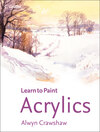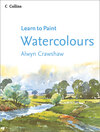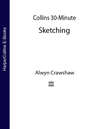Buch lesen: «Acrylics»

Copyright

Off Home, acrylic on canvas, 30 × 25 cm (12 × 10 in)
HarperCollinsPublishers Ltd
1 London Bridge Street
London SE1 9GF
First published in 1979
by William Collins Sons & Co Ltd, London
This edition published by HarperCollinsPublishers 2019
© Alwyn Crawshaw 1979, 1986, 1999
A catalogue record for this book is available from the British Library
Photography by Nigel Cheffers-Heard and Michael Petts
Alwyn Crawshaw asserts the moral right to be identified as the author of this work.
All rights reserved under International and Pan-American Copyright Conventions. By payment of the required fees, you have been granted the nonexclusive, non-transferable right to access and read the text of this e-book on screen. No part of this text may be reproduced, transmitted, downloaded, decompiled, reverse engineered, or stored in or introduced into any information storage retrieval system, in any form or by any means, whether electronic or mechanical, now known or hereinafter invented, without the express written permission of HarperCollins e-books.
Source ISBN 9780007458691
Ebook Edition © MAY 2019 ISBN: 9780008363246
Version: 2019-05-13
HarperCollinsPublishers has made every reasonable effort to ensure that any picture content and written content in this ebook has been included or removed in accordance with the contractual and technological constraints in operation at the time of publication.
Note to Readers
This ebook contains the following accessibility features which, if supported by your device, can be accessed via your ereader/accessibility settings:
Change of font size and line height
Change of background and font colours
Change of font
Change justification
Text to speech
Page numbers taken from the following print edition: ISBN 9780007458691
Contents
Cover
Title Page
Copyright
Note to Readers
Portrait of an Artist
Introduction
What are Acrylic Colours?
Materials and Equipment
Mixing Colours
Brush Control
Perspective, Shape and Form
Oil Technique
OIL TECHNIQUE
Simple Exercises
Watercolour Technique
WATERCOLOUR TECHNIQUE
Simple Exercises
OIL TECHNIQUE DEMONSTRATION
Hedgerow Poppies
OIL TECHNIQUE DEMONSTRATION
Norfolk Pheasant
OIL TECHNIQUE DEMONSTRATION
Evening Landscape
OIL TECHNIQUE DEMONSTRATION
The Grand Canal, Venice
WATERCOLOUR TECHNIQUE DEMONSTRATION
Spring Landscape
WATERCOLOUR TECHNIQUE DEMONSTRATION
Winter Landscape
WATERCOLOUR TECHNIQUE DEMONSTRATION
Venetian Canal
About the Publisher

Norfolk Pheasant, acrylic on primed hardboard, 25 × 28 cm (10 × 12 in)
Portrait of the Artist

Alwyn Crawshaw working outdoors.
Successful painter, author and teacher Alwyn Crawshaw was born at Mirfield, Yorkshire, and studied at Hastings School of Art. He now lives in Norfolk with his wife June, who is also an artist.
Alwyn is a Fellow of the Royal Society of Arts, and a member of the British Watercolour Society and the Society of Equestrian Artists. He is also President of the National Acrylic Painters Association and is listed in the current edition of Who’s Who in Art. As well as painting in watercolour, Alwyn also works in oil, acrylic and occasionally pastel. He chooses to paint landscapes, seascapes, buildings and anything else that inspires him. Heavy working horses and winter trees are frequently featured in his landscape paintings and may be considered the artist’s trademark.
This book is one of eight titles written by Alwyn Crawshaw for the HarperCollins Learn to Paint series. Alwyn’s other books for HarperCollins include: The Artist At Work (an autobiography of his painting career), Sketching with Alwyn Crawshaw, The Half-Hour Painter, Alwyn Crawshaw’s Watercolour Painting Course, Alwyn Crawshaw’s Oil Painting Course, Alwyn Crawshaw’s Acrylic Painting Course and Alwyn & June Crawshaw’s Outdoor Painting Course.
To date Alwyn has made seven television series: A Brush with Art, Crawshaw Paints on Holiday, Crawshaw Paints Oils, Crawshaw’s Watercolour Studio, Crawshaw Paints Acrylics, Crawshaw’s Sketching & Drawing Course and Crawshaw Paints Constable Country, and for each of these he has written a book of the same title to accompany the television series.
Alwyn has been a guest on local and national radio programmes and has appeared on various television programmes. In addition, his television programmes have been shown worldwide, including in the USA and Japan. He has made many successful videos on painting and is also a regular contributor to the Leisure Painter magazine and the International Artist magazine. Alwyn and June organize their own successful and very popular painting courses and holidays. They also co-founded the Society of Amateur Artists, of which Alwyn is President.
Alwyn’s paintings are sold in British and overseas galleries and can be found in private collections throughout the world. His work has been favourably reviewed by the critics. The Telegraph Weekend Magazine reported him to be ‘a landscape painter of considerable expertise’ and the Artists and Illustrators magazine described him as ‘outspoken about the importance of maintaining traditional values in the teaching of art’.

A Norfolk Fishing Harbour primed hardboard 30 × 40 cm (12 × 16 in) I was inspired to do this painting by the sunlight hitting the buildings.

Willows at Potter Heigham, Norfolk primed hardboard 12 × 28 cm (10 × 12 in) When I came upon this scene, I was inspired by the strong sunlight. The dark rain clouds and heavy shadows on the trees in the middle distance made the picture even more dramatic.
Introduction
Why use acrylic colours? I am constantly asked this question. The answer is that I like using them and they suit my personality. I believe that a painting comes from the inner self and this gives it the mood, the atmosphere, the invisible quality that makes it look alive. If you were inspired to paint a particular landscape and could paint it in, say, three minutes while that urge was there, then the painting would express your uninterrupted feelings on the canvas.

How Much Longer Have We To Wait? detail on canvas 25 × 25 cm (10 × 10 in)
Now, three minutes to paint a picture is ridiculous but, because acrylic colours dry so quickly, a certain speed is possible. As one stage of the painting is done, you can overpaint almost immediately without picking up the paint from underneath and consequently you can keep working while the inspiration is there.
If circumstances permit, you can start a painting in the morning and finish it in the afternoon, as each stage will be dry enough for you to follow on with the next. If you like to put detail in a picture, this can be done as and when you feel it necessary because the paint will dry quickly enough to allow you to work on top of the previous layer.
This direct way of painting is one of the reasons why acrylic painting suits me. Another very useful factor is that no smell is given off when using acrylics, unlike oils.
Naturally, as with all painting, there are techniques to be learned and certain disciplines to be acquired before you can master the medium. As the reader of this book, you have taken your first big step. If you are a beginner, curious about painting and wanting to find out more about it, you have selected acrylics as the medium with which to start. If you already paint and are reading this book to learn about the medium of acrylic colour then, whatever other medium you paint in, do start with the basic exercises. Remember, a new medium requires different techniques.
I will take you through this book stage by stage, working very simply to start with and progressing to a more mature form of painting. If you have some acrylic colours, your desire to try them out will most probably have been stimulated by looking through the book and seeing the variety of images and different methods of working. However, I strongly recommend that you relax and read on before you actually pick up a brush. More haste – less speed!
If you find some exercises difficult to master, go a stage further and then come back. Seeing a problem with a fresh eye will make it easier to solve. Good luck!

The Red Boat, Norfolk primed hardboard 25 × 28 cm (10 × 12 in) I couldn’t resist this red boat and all the quayside structures, which I spotted when painting the Norfolk Fishing Harbour scene here. You can just see the red boat at the extreme left of that painting.
What are Acrylic Colours?

The paint in the red tube is Cryla Flow Colour. The paint in the green tube is Cryla Colour.
Acrylic colours first arrived on the market in this country in 1963. Daler-Rowney produce two ranges of acrylic colour which I use, Cryla Colour and Cryla Flow Colour.
Cryla Colour is very thick, has a buttery texture similar to oil colour and comes in a small tube. Because of its consistency it is used mainly for palette knife work. As with oils, an acrylic painting can be built up to achieve a tremendous amount of relief work (impasto). The immediate advantage of acrylics over oil colours used in this way is that oils take months to dry but acrylics take only hours, even when put on really thickly.
I prefer to use brushes with this medium. This is where the other type of acrylic colour, Cryla Flow Colour, comes in, as it is better to use with a brush. Unless stated, I have used Cryla Flow Colour for all the exercises in this book. This type of acrylic colour comes in a longer tube. You can add Gel Retarder to slow down the drying time and use Texture Paste for building up heavy impasto. There are also high-quality nylon brushes on the market, which I use all the time and find best for all my acrylic painting, apart from small detail work.
A Stay-Wet Palette keeps the paint wet on the palette almost indefinitely, saving a lot of paint from being wasted by the paint drying too soon. I strongly recommend the use of this.
A choice of techniques
One very unique and exciting property of working with acrylic colour is that you can paint in an ‘oil’ painting technique or in a ‘watercolour’ painting technique, or use both techniques in the same picture – see my two paintings (below). These two different ways of working are described later in the book.

The Snow Drift acrylic watercolour technique on Waterford watercolour paper 300 lb Rough 50 × 75 cm (20 × 30 in) I worked this painting without using any white paint – just as I would a watercolour. The dark sky helps to make the snow (unpainted white paper) look even whiter.

Yachts and Wind, Potter Heigham acrylic oil technique on primed hardboard 25 × 28 cm (10 × 12 in) Notice how much movement there is in this painting. The clouds, the yacht sails and the water all help to give the illusion of a busy, blustery, sunny day. I painted it with my normal oil technique.
Der kostenlose Auszug ist beendet.












